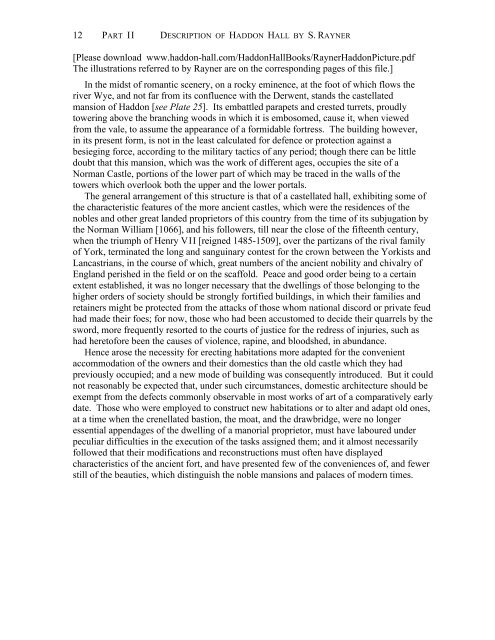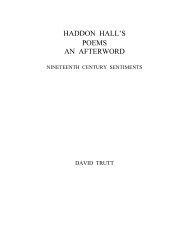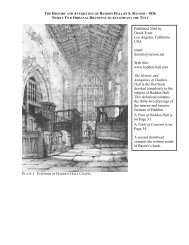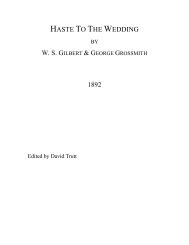Download - Haddon Hall
Download - Haddon Hall
Download - Haddon Hall
Create successful ePaper yourself
Turn your PDF publications into a flip-book with our unique Google optimized e-Paper software.
12 PART II DESCRIPTION OF HADDON HALL BY S. RAYNER<br />
[Please download www.haddon-hall.com/<strong>Haddon</strong><strong>Hall</strong>Books/Rayner<strong>Haddon</strong>Picture.pdf<br />
The illustrations referred to by Rayner are on the corresponding pages of this file.]<br />
In the midst of romantic scenery, on a rocky eminence, at the foot of which flows the<br />
river Wye, and not far from its confluence with the Derwent, stands the castellated<br />
mansion of <strong>Haddon</strong> [see Plate 25]. Its embattled parapets and crested turrets, proudly<br />
towering above the branching woods in which it is embosomed, cause it, when viewed<br />
from the vale, to assume the appearance of a formidable fortress. The building however,<br />
in its present form, is not in the least calculated for defence or protection against a<br />
besieging force, according to the military tactics of any period; though there can be little<br />
doubt that this mansion, which was the work of different ages, occupies the site of a<br />
Norman Castle, portions of the lower part of which may be traced in the walls of the<br />
towers which overlook both the upper and the lower portals.<br />
The general arrangement of this structure is that of a castellated hall, exhibiting some of<br />
the characteristic features of the more ancient castles, which were the residences of the<br />
nobles and other great landed proprietors of this country from the time of its subjugation by<br />
the Norman William [1066], and his followers, till near the close of the fifteenth century,<br />
when the triumph of Henry VII [reigned 1485-1509], over the partizans of the rival family<br />
of York, terminated the long and sanguinary contest for the crown between the Yorkists and<br />
Lancastrians, in the course of which, great numbers of the ancient nobility and chivalry of<br />
England perished in the field or on the scaffold. Peace and good order being to a certain<br />
extent established, it was no longer necessary that the dwellings of those belonging to the<br />
higher orders of society should be strongly fortified buildings, in which their families and<br />
retainers might be protected from the attacks of those whom national discord or private feud<br />
had made their foes; for now, those who had been accustomed to decide their quarrels by the<br />
sword, more frequently resorted to the courts of justice for the redress of injuries, such as<br />
had heretofore been the causes of violence, rapine, and bloodshed, in abundance.<br />
Hence arose the necessity for erecting habitations more adapted for the convenient<br />
accommodation of the owners and their domestics than the old castle which they had<br />
previously occupied; and a new mode of building was consequently introduced. But it could<br />
not reasonably be expected that, under such circumstances, domestic architecture should be<br />
exempt from the defects commonly observable in most works of art of a comparatively early<br />
date. Those who were employed to construct new habitations or to alter and adapt old ones,<br />
at a time when the crenellated bastion, the moat, and the drawbridge, were no longer<br />
essential appendages of the dwelling of a manorial proprietor, must have laboured under<br />
peculiar difficulties in the execution of the tasks assigned them; and it almost necessarily<br />
followed that their modifications and reconstructions must often have displayed<br />
characteristics of the ancient fort, and have presented few of the conveniences of, and fewer<br />
still of the beauties, which distinguish the noble mansions and palaces of modern times.







